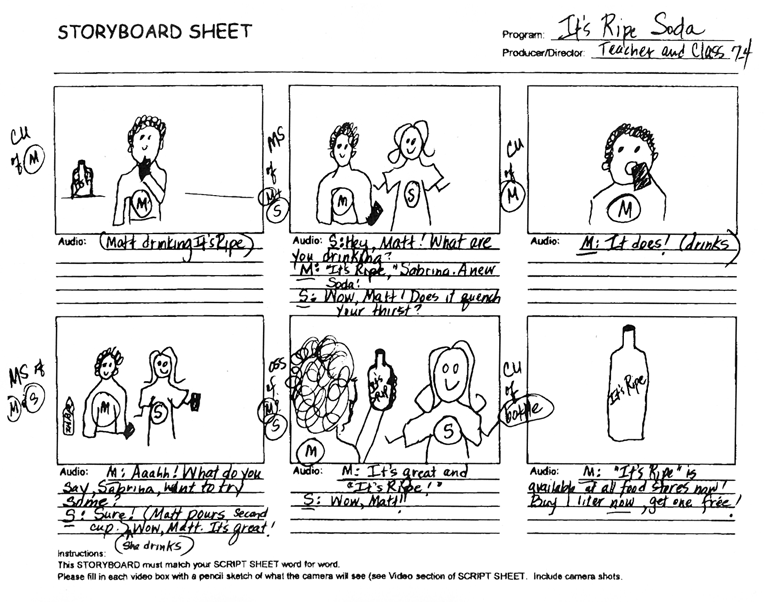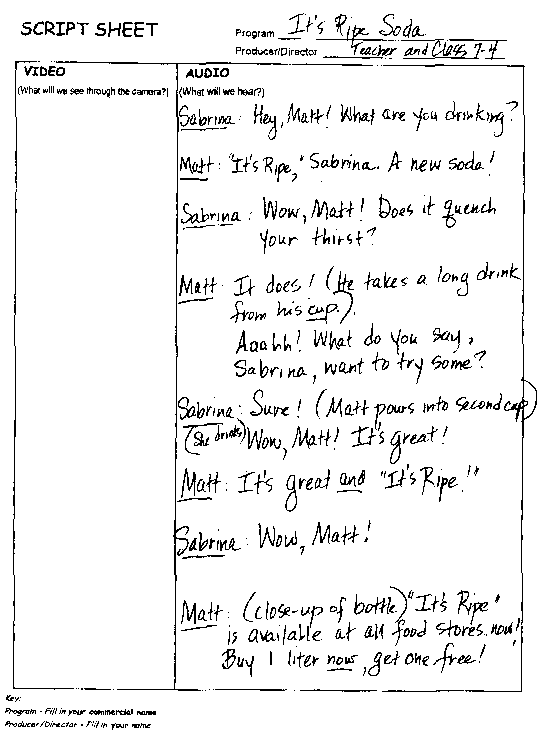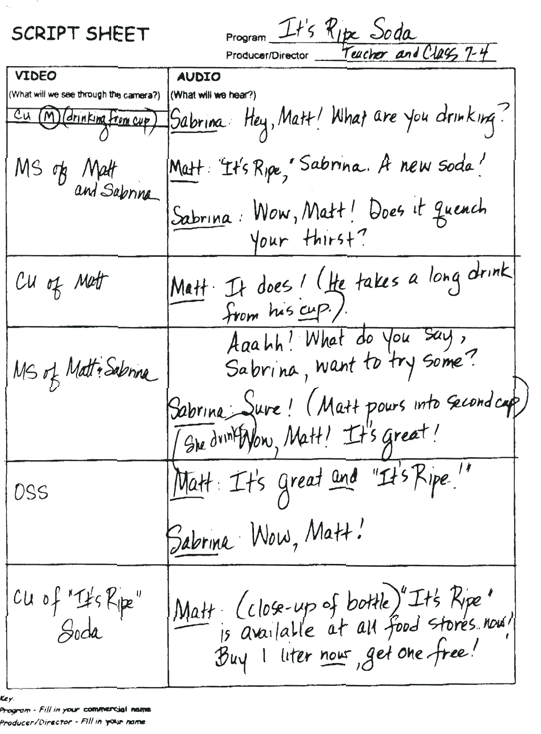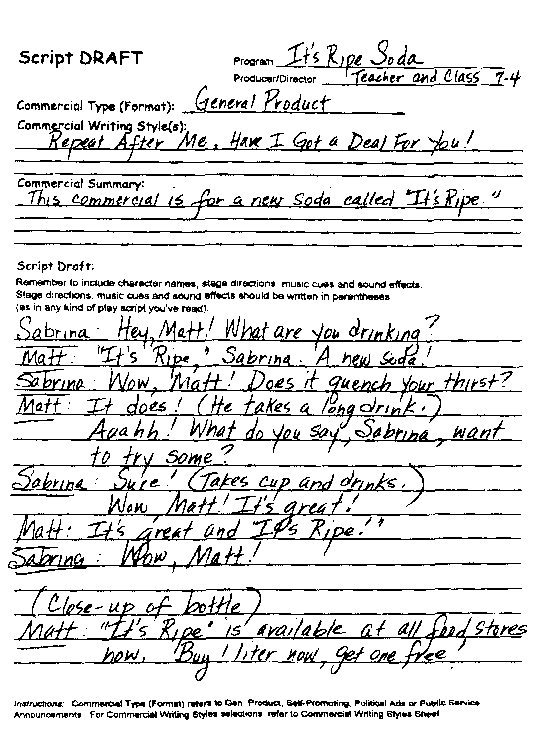I.S.
24, S.I., NY
(Grades
6-12)
| 1: The four commercial types | 3: Developing a script draft | Notes |
| 2: Commercial writing styles | 4-6: Developing and producing a commercial | Sample completed student worksheets |
Time
Required: 60
Minutes
Advance
Preparation:
Prepare
4 charts labeled as follows – General Product Ad, Self-Promoting Ad, Political
Ad, and Public Service Announcement (“PSA”).
Materials
Required:
Chart paper, markers, magnets, and post-it notes (3”x5”).
Aim:
What are the four different Commercial
Types (Formats)?
Motivation:
Have students break into groups of 5. Say
- “I’d like you to work together to come up with a list of 10 commercials on
television that you love or hate, or that just stand out in your mind for any
reason at all.” Allow students
about 5 minutes to come up with their lists.
Ask
class to share some of the commercials on their lists.
Ask - “What is the purpose of each of these commercials?
(They try to sell you something – a product, service, or candidate).
Say
- “Every commercial falls into one of four Commercial
Types. Today we are going to
learn about these four different Commercial
Types.”
Show
students Commercial Types you have listed individually on chart paper (or
chalkboard).
Below is the information you will need on each:
Political Ads – These are commercials for politicians. They include positive or negative information about a candidate running for office.
Public Service Announcement (“PSAs”) – These are service announcements to the public (viewing audience). PSAs don’t sell you anything – they offer free advice, bring important information to your attention, offer assistance, teach you, etc. Examples: anti-drug commercials, suicide help lines, free breast cancer screenings, and Be-A-Mentor.
Say
– “Let’s start with the easiest, the Political Ad.
What are they “selling” in this commercial/ad?”
Discuss any recent political ads students have seen.
Continue having students try to guess what other commercial/ads are “selling.”
Continue
your lesson, having students try to guess what kinds of commercials fall under
the Commercial
Types learned.
Activity:
Have students work in groups (previously arranged) to classify their list of
Next,
have the students come up with 3 more existing commercials for each
of the four Commercial Types. Distribute
post-it notes to each group and instruct them to write each commercial
description on a separate post-it note. Each
group should end up with 12 post-it notes (3 commercials for each of 4 Commercial
Types =12). Allow 5 to 7
minutes for this part of the activity. After
the allotted time, ask each group to come up and place its commercials on the
appropriate Commercial
Types charts.
Example: 1-800-USLAWYERS is not a PSA.
Why not? (Because in PSA’s, you are not asked to buy any product
or service). Or, Why is a “Rosie” commercial a self-promoting ad? (Because
the commercial is promoting a show).
Spend
about 10 to 15 minutes on reviewing this activity.
Note:
This is a good time to separate Public Service Announcements from the
other Commercial
Types. Please refer to Unit: Producing Public Service
Announcements for Videotaping (http://teachnet.org/teachnetnyc/nacionales/psa.htm)
for further information/explanation. Tell
students that for the remainder of the Unit, only the other 3 Commercial Types will be
discussed.
Review
each of the Commercial Writing Styles with the students.
The students should fill in information about each writing style as
dictated by you.
Activity:
Have students watch one of your videotaped commercials.
Ask students, “Which Commercial Writing Style
was used in this commercial?” Discuss
why it is a particular writing style and not another.
Please note, some commercials fall under more than one writing style.
Share this with the students.
Watch
more of your videotaped commercials and discuss their Commercial Writing Styles.
You can also use this time to review Commercial
Types.
Evaluation: Test Prepared for Commercial Writing Styles and Commercial Types. NOTE: This is a 2 page test and is set for landscape print.
| Click
here and download the Microsoft Word file |
Class
________
Date __________________
Advertisers use different techniques to bring their products or message to your attention. This is exhibited in their writing styles(s). Below are several commercial writing styles. We will work together to fill in the definitions for each.
Hop
on the Bandwagon
________________________________________________________________________________________________________________________________________________
The
Testimonial
________________________________________________________________________________________________________________________________________________
Just
Give Me the Facts and Figures
________________________________________________________________________________________________________________________________________________
Contains
Magic Ingredients
________________________________________________________________________________________________________________________________________________
We
Know What You Fear
________________________________________________________________________________________________________________________________________________
We’re
Better
________________________________________________________________________________________________________________________________________________
Repeat
After Me
________________________________________________________________________________________________________________________________________________
For
You Plain Folks and Snobs Out There
________________________________________________________________________________________________________________________________________________
Glittering
Generality
________________________________________________________________________________________________________________________________________________
Weasel
Words
________________________________________________________________________________________________________________________________________________
Have
I Got a Deal For You
________________________________________________________________________________________________________________________________________________
Transference
________________________________________________________________________________________________________________________________________________
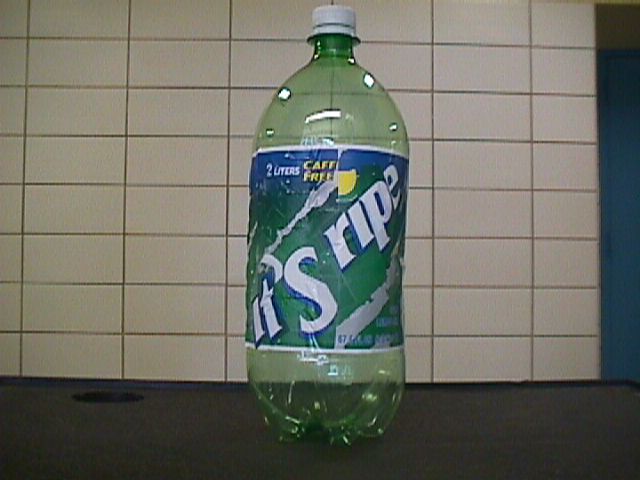
Say
– “I’d like to make a fabulous commercial for my soda.
It is going to be a TV commercial. Together
we must prepare a checklist for our commercial.
Our checklist, or outline, will help us organize our work for our
commercial. What should that check
list contain?”
-
Select product/service name
-
Design your product or product logo (like soda can, cereal box, sneaker)
-
Select your Commercial Writing Style(s)
-
Prepare script draft (about 90 words, 15-30 seconds long). Use Script
Draft Sheet.
-
Complete Script Sheet (Audio section)
-
Complete Script Sheet (Video section)
-
Complete Storyboard Sheet
-
Videotape your commercial!
Begin
working with your class to prepare a draft script for the “It’s Ripe”
product. Do this on an
enlarged Script Draft Sheet.
Script DRAFT |
Program _______________________________________ |
|
|
Producer/Director _______________________________ |
|
|
|
|
Commercial
Type (Format): ____________________________ |
|
|
Commercial
Writing Style(s): |
|
|
|
|
|
|
|
|
|
|
|
Commercial
Summary: |
|
|
|
|
|
|
|
|
|
|
|
|
|
|
|
|
|
Script
Draft: |
|
|
Remember to include character names, stage
directions, music cues and sound effects. |
|
|
Stage directions, music cues and sound
effects should be written in parentheses |
|
|
(as in any kind of play script you've
read). |
|
|
|
|
|
|
|
|
|
|
|
|
|
|
|
|
|
|
|
|
|
|
|
|
|
|
|
|
|
|
|
|
|
|
|
|
|
|
|
|
|
|
|
Instructional
Objectives:
Students will learn how to complete a Script Sheet and Storyboard Sheet
for teacher’s television commercial, and will develop and produce their own.
|
Click here to download Word or Excel files of: Shot
Composition Sheet (Right click - choose "save target as") |
·
Review difference between video
and audio section of the Script
Sheet..
Video – What camera shots will we use?
Who/What will we see?
Audio – Who/What will we hear during the commercial
– voices, music, sound effects?
·
Show Script Sheet with audio
section completed
·
Your Script Draft Sheet (from Day 3) should be used to complete the
audio section. Add music cues, sound
effects, and directions for actors where necessary.
·
Review Shot Composition Sheet and
explain why it is used (It shows camera shots and abbreviations necessary for
Script Sheet video section).
Complete
video section of the Script
Sheet. Ask, “What shot do
we want to use at the opening of our commercial?
At the end of our commercial?
·
Introduce the Storyboard Sheet
The boxes on the Storyboard
(called video boxes) represent the video portion of the Script Sheet. A
pencil sketch is put in each box to represent camera shots used.
·
Work with the students to complete the Storyboard for the “It’s
Ripe” Script Sheet. Do a
comparison of the Script Sheet and the Storyboard.
Does the information match up? It
MUST.
The
“It’s Ripe” commercial is ready to be videotaped.
Select 2 students for roles of Sabrina and Matt. Provide
each with Script Sheets for the commercial so
that they can rehearse. Select a
student to videotape the commercial and provide him/her with the Script
Sheet and Storyboard Sheet.
http://pbs.org/30secondcandidate/
contains
historical information on political ads, including which politician was the
first to run an ad.
http://adcritic.com/
allows
you to watch over 400 commercials online. A
bit slow to load, but worth checking out.
http://teenwriting.about.com/library/weekly/aa083099.htm Heroes for Writing Slogans - Page 1 discusses
the importance of a good slogan in a commercial.
Students may want to include slogans in their commercials.
Sample Student Completed Worksheets:
